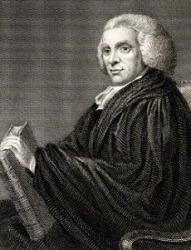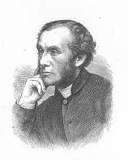Planning worship?
Check out our sister site, ZeteoSearch.org,
for 20+ additional resources related to your search.
- |
User Links
Person Results
Gregory Murray
1905 - 1992 Person Name: A. Gregory Murray, OSB Topics: Pentecost Sunday Composer of "[Alleluia, alleluia, alleluia]" in Gather (3rd ed.)
Gregory Murray
William Jones

1726 - 1800 Person Name: William Jones (1726-1800) Topics: The Fourth Sunday of Advent Year C; The Second Sunday of Advent Year A Composer of "ST STEPHEN (NEWINGTON)" in Ancient and Modern Born: July 30, 1726, Lowick, Northamptonshire, England.
Died: January 6, 1800, Hollingbourne, Kent, England.
Pseudonym: Jones of Nayland.
Jones was educated at Charterhouse and University College, Oxford. He became Vicar of Bethersden, Kent (1764); Pluckley, Kent; and Paston, Northamptonshire; perpetual Curate of Nayland, Suffolk (1777); and Rector of Hollingbourne, Kent (1798). He became a Fellow of the Royal Society in 1775. His works include:
The Catholic Doctrine of the Trinity, 1756
Fairchild Discourses, 1775
Physiological Disquisitions, 1781
A Treatise on the Art of Music, 1784
Church Pieces for the Organ with Four Anthems in Score, 1789
Jones was a descendant of the Col. J. Jones, who was one of the signatories to the death warrant of King Charles I of England. He used to regularly observe January 30 as a day of fasting and humiliation for his ancestor’s sin.
Music:
ST. STEPHEN
--www.hymntime.com/tch/
William Jones
Eleanor Hull
1860 - 1935 Person Name: Eleanor Henrietta Hull (1860-1935) Topics: The Third Sunday of Advent Year B; The Third Sunday of Lent Year B Versifier of "Be thou my vision, O Lord of my heart" in Ancient and Modern
Eleanor Hull
Jonathan C. Woodman
1813 - 1894 Person Name: J. C. Woodman Topics: The Church Sunday School Composer of "STATE STREET" in The Baptist Standard Hymnal
Jonathan C. Woodman
William Dalrymple Maclagan

1826 - 1910 Person Name: William D. MacLagan Topics: Sunday Schools Closing Hymns Composer of "BREAD OF HEAVEN" in The Hymnal Maclagan, William Dalrymple , D.D., son of David Maclagan, M.D., was born in Edinburgh, June 18, 1826. In early life he entered the army, and served for some time in India. Retiring with the rank of lieutenant, he entered St. Peter's College, Cambridge, where he graduated B.A. 1856 and M.A. in 1860. Taking Holy Orders, he was curate of St. Saviour's, Paddington, 1856-58, and St. Stephen's, Marylebone, 1858-60. He then became Secretary to the London Diocesan Church Building Society, from 1860 to 1865; curate of Enfield, 1865-69; Rector of Newington, 1869-75; and Vicar of Kensington, 1875-78. He was also Hon. Chaplain to the Queen, and Prebendary of Reculverland in St. Paul's Cathedral, London. In 1878 he was consecrated Bishop of Lichfield. Bishop Maclagan's work has been mainly of a practical character, and his publications are few. The few hymns which he has written have been received with great favour, and create a desire for more of the same kind and quality. The following are in common use.:—
1. Again the trumpet sounds. Missions. Written about 1870. Appeared in the Hymns Ancient & Modern Hymns Ancient & Modern series of Hymns for Mission Services. 1871.
2. Be still, my soul, for God is near. Holy Communion. Part ii. is “O Body, broken for my sake." Written about 1873 for St. Mary's, Newington. In Thring's Collection, 1882.
3. Holy Spirit, Lord of love. Confirmation. Written about 1873, and published in Mrs. C. Brock's Children's Hymn Book, 1884.
4. It is finished, blessed Jesus [Saviour]. Good Friday. Written for Hymns Ancient & Modern, 1875. In several collections.
5. Lord, when Thy Kingdom comes, remember me. Good Friday. Written for the 1875 ed. of Hymns Ancient & Modern. Sometimes given in two parts: Pt. ii. Beginning, “Lord, when with dying lips my prayer is said."
6. The Saints of God their conflict past. All Saints. First published in Church Bells, 1870; and again in the Society for Promoting Christian Knowledge Church Hymns, 1871.
7. What thanks and praise to Thee we owe. St. Luke. Written for the 1875 edition of Hymns Ancient & Modern
These hymns are of more than usual merit, being characterized by great simplicity, tenderness, and fervour. The special season or purpose is clearly indicated, and its lessons earnestly enforced.
-- John Julian, Dictionary of Hymnology (1907)
=============
Maclagan, Abp. W. D., pp. 709, i.; 1578, ii. At the present time all Abp. Maclagan's hymns are in common use, and most of his tunes likewise. With regard to the latter, it is exceptional to find so many tunes by the author of popular hymns sharing the same popularity in the principal hymnals. In Church Hymnal, 1903, and Hymns Ancient & Modern, 1904, combined, there are eight of his tunes, whilst the hymns are six in all.
--John Julian, Dictionary of Hymnology, New Supplement (1907)
William Dalrymple Maclagan
Edward Augustus Horton
1843 - 1931 Person Name: Edward A. Horton Topics: Flower or Children's Sunday Author of "Spring and Summer" in A Book of Song and Service Horton, Rev. Edward Augustus. (Springfield, Massachusetts, September 28, 1843--April 15, 1931, Toronto, Canada). He studied at the University of Chicago and at Meadville Theological School, from which he graduated in 1868. He served Unitarian churches in Leominster, Mass., 1868-1875; Hingham, Mass., 1877-1880; and the Second Church in Boston, 1880-1892. Thereafter he was active in the work of the Unitarian Sunday School Society. In 1912, he wrote an "Anniversary Hymn" beginning "We honor those whose work began" which was included in The New Hymn and Tune Book, 1914.
--Henry Wilder Foote, DNAH Archives
Edward Augustus Horton
Jimmy Owens
b. 1930 Topics: Trinity Sunday The Trinity Composer of "COME TOGETHER" in Hymns for Today's Church (2nd ed.) Owens, James Lloyd (Jimmy). (Clarksdale, Mississippi, December 9, 1930-- ). Foursquare. Attended Millsaps College, Jackson, Miss.; Southwestern College, Memphis, Tennessee; Cathedral School of the Bible, Oakland, California; Cabot College, San Leandro, Calif. Minister of Music, The Neighborhood Church, Oakland, Calif., 1951-1966; Minister of Music, United Community Church, Glendale, Calif., 1966-1968; Minister of Music, Anaheim Christian Center (now Melodyland Christian Center), Anaheim, Calif., 1968-1969.
With his wife Carol, Owens has composed four Christian musicals. He has recorded several albums.
--Terry W. York, DNAH Archives
Jimmy Owens
John Stainer

1840 - 1901 Person Name: John Stainer (1840-1901) Topics: The Fifth Sunday of Easter Year B; The Fourth Sunday of Epiphany Year C; The Third Sunday before Advent Year A; The Third Sunday before Lent Year C Composer of "LOVE DIVINE" in Ancient and Modern
John Stainer
John Goss

1800 - 1880 Topics: Sundays after Trinity Praise and Adoration; Sunday Schools Trinity Sunday; Sunday Schools General Use Composer of "LAUDA ANIMA" in The Hymnal John Goss (b. Fareham, Hampshire, England, 1800; d. London, England, 1880). As a boy Goss was a chorister at the Chapel Royal and later sang in the opera chorus of the Covent Garden Theater. He was a professor of music at the Royal Academy of Music (1827-1874) and organist of St. Paul Cathedral, London (1838-1872); in both positions he exerted significant influence on the reform of British cathedral music. Goss published Parochial Psalmody (1826) and Chants, Ancient and Modern (1841); he edited William Mercer's Church Psalter and Hymn Book (1854). With James Turle he published a two-volume collection of anthems and Anglican service music (1854).
Bert Polman
John Goss
Martin Madan

1726 - 1790 Topics: Sunday Schools Ascension; Sunday Schools Eastertide; Sunday Schools Author of "Hail, Thou once despised Jesus!" in The Hymnal Madan, Martin, son of Colonel Martin Madan, and brother of Dr. Spencer Madan, sometime Bishop of Peterborough, was born in 1726. He was to have qualified for the Bar, but through a sermon by J. Wesley on the words "Prepare to meet thy God," the whole current of his life was changed. After some difficulty he received Holy Orders, and subsequently founded and became chaplain of the Lock Hospital, Hyde Park Corner. He was popular as a preacher, and had no inconsiderable reputation as a musical composer. He ceased preaching on the publication of his work Thelyphthora, in which he advocated the practice of polygamy. He died in 1790. He published A Commentary on the Articles of the Church of England; A Treatise on the Christian Faith, &c, and:- A Collection of Psalms and Hymns Extracted from Various Authors, and published by the Reverend Mr. Madan. London, 1760.
This Collection contained 170 hymns thrown together without order or system of any kind. In 1763 he added an Appendix of 24 hymns. This Collection, referred to as Madam’s Psalms & Hymns, had for many years a most powerful influence on the hymnody of the Church of England. Nearly the whole of its contents, together with its extensively altered texts, were reprinted in numerous hymnbooks for nearly one hundred years. At the present time many of the great hymns of the last century are in use as altered by him in 1760 and 1763. Although several hymns have been attributed to him, we have no evidence that he ever wrote one. His hymnological labours were employed in altering, piecing, and expanding the work of others. And in this he was most successful.
-- John Julian, Dictionary of Hymnology (1907)
============================
Martin Madan


 My Starred Hymns
My Starred Hymns


